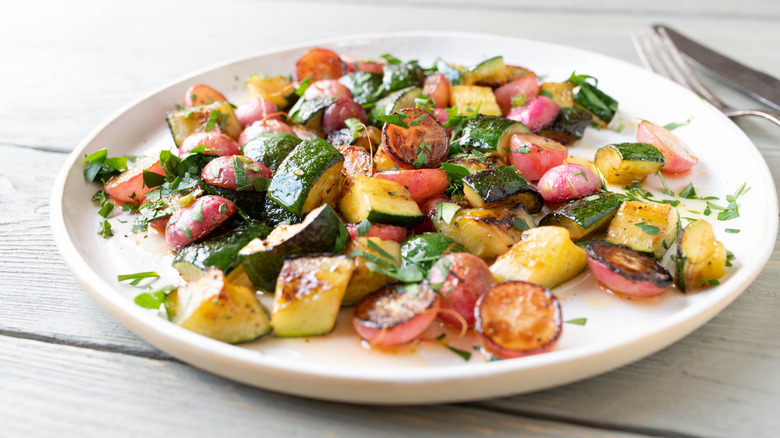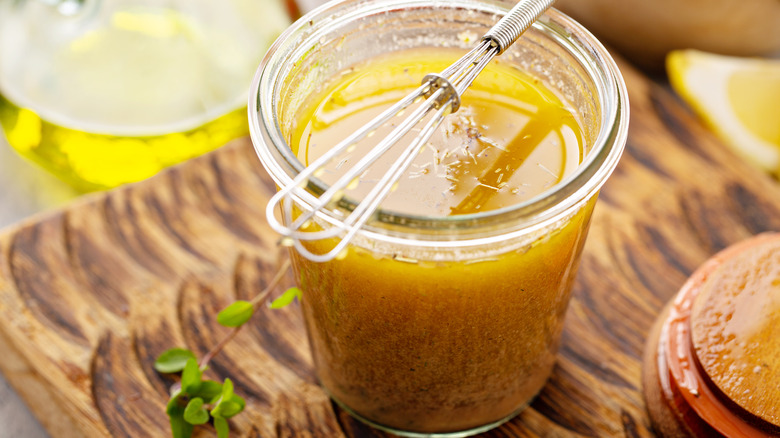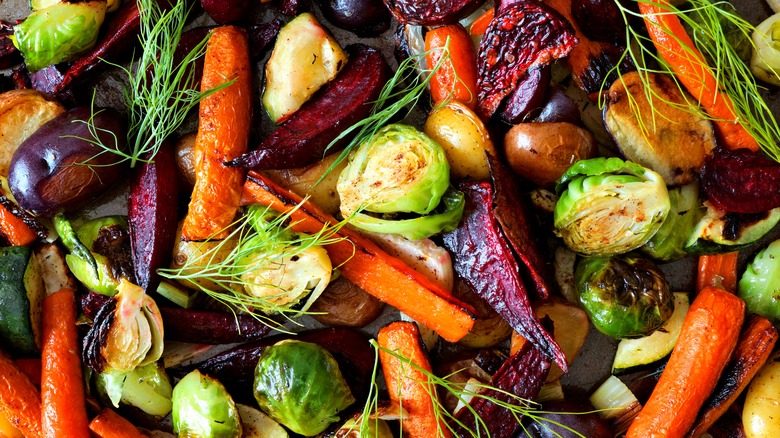Roast Your Veggies In Salad Dressing For A Wonderfully Caramelized Bite
Condiments. We've all got 'em — lots of them, in fact. The average full-size fridge usually holds at least five or six bottles, and some of us have as many as 15 to 20 bottles taking up space on the refrigerator door. One of the biggest culprits? Store-bought salad dressing. Unlike ketchup and mustard, which are workhorse toppings that get used for multiple meals, a lot of us use salad dressings only for seasoning green salads, so they can start to stack up over time and go out of date before they're used up. Salad dressings can work in a lot more than just salads, however. These mixtures are also perfectly balanced marinades, which are perfect for roasting up some fresh vegetables. With dressings having some added sweetness to balance their acidity, they can help your vegetables caramelize nicely in the oven.
If you've got a couple of bottles of store-bought salad dressing taking up space in your fridge, all you need to do to marinate vegetables like zucchini, eggplant, asparagus, and sweet potatoes (to name a few), is to toss them in a bowl with a few tablespoons of dressing and then pop them in the oven to roast. It's that easy!
What's in a salad dressing
We take for granted that salad dressings are all mixed up in a bottle for us when we buy them at the grocery store, but most salad dressings and marinades are essentially the same thing: a mix of oil, vinegar, sugar, and spices. While the natural flavors of vegetables are great, it's nice to have some variations in taste to keep dinner interesting, and if you've got a shelf full of salad dressings you've always got tons of options for flavoring roasted vegetables. It's a great way to get picky kids more interested in vegetables if they have a favorite salad dressing, and if one flavor isn't a hit you can just try another bottle next time.
Vinaigrettes are the best choice for veggie marinades as they have more vinegar in them, which gives them a robust, acidic flavor that will stand up to roasting. Some creamy dressings can work, too, however, like creamy Italian, Greek, or balsamic. As long as your dressing has a strong, sharp backbone, it'll probably make a good vegetable marinade, and the sweetness should give the dish a delicious hint of caramelization. You don't have to limit yourself to bottled dressings either. If you have a reason to make a batch of homemade vinaigrette for a special salad, double the dressing recipe and save half for marinating vegetables later in the week.
Marinate quickly or marinate overnight
The easiest way to use salad dressing on your roasted vegetables is to toss them with the marinade right before you put them in the oven. Salad dressing marinade is also nice for grilling vegetables. Just be sure you cook them over indirect heat so that the oil dripping off doesn't spark large flames.
Salad dressings also make great overnight marinades, too. Veggies like mushrooms, onions, corn on the cob, potatoes, carrots, and beets all take on a lot more flavor if you give them more time in contact with the dressing. All you have to do is pop your prepped vegetables to be marinated in a large ziplock bag, then pour the salad dressing in, making sure to use enough so that all the vegetables are coated. Then, seal the bag and pop the whole thing in the refrigerator overnight. When it's time to cook, your veggies will be perfectly flavored and ready to go.
Once you start looking at your dressings as less of a final step and more of an ingredient, you might start using them to marinate more than just veggies. Salad dressing marinade is great for tofu and tempeh, chicken, and fish. It's even good for marinating veggies for antipasto like canned artichoke hearts, white beans, olives, roasted garlic, and roasted red peppers. It's so easy, you'll never throw another bottle of expired salad dressing in the trash again!


